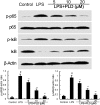Platycodin D Inhibits Inflammatory Response in LPS-Stimulated Primary Rat Microglia Cells through Activating LXRα-ABCA1 Signaling Pathway
- PMID: 29375565
- PMCID: PMC5767310
- DOI: 10.3389/fimmu.2017.01929
Platycodin D Inhibits Inflammatory Response in LPS-Stimulated Primary Rat Microglia Cells through Activating LXRα-ABCA1 Signaling Pathway
Abstract
Platycodin D (PLD), an effective triterpenesaponin extracted from Platycodon grandiflorum, has been known to have anti-inflammatory effect. In the present study, we investigate the anti-inflammatory effects of PLD on LPS-induced inflammation in primary rat microglia cells. The results showed that PLD significantly inhibited LPS-induced ROS, TNF-α, IL-6, and IL-1β production in primary rat microglia cells. PLD also inhibited LPS-induced NF-κB activation. Furthermore, our results showed that PLD prevented LPS-induced TLR4 translocation into lipid rafts via disrupting the formation of lipid rafts by inducing cholesterol efflux. In addition, PLD could activate LXRα-ABCA1 signaling pathway which induces cholesterol efflux from cells. The inhibition of inflammatory cytokines by PLD could be reversed by SiRNA of LXRα. In conclusion, these results indicated that PLD prevented LPS-induced inflammation by activating LXRα-ABCA1 signaling pathway, which disrupted lipid rafts and prevented TLR4 translocation into lipid rafts, thereby inhibiting LPS-induced inflammatory response.
Keywords: LPS; LXRα; NF-κB; TLR4; platycodin D.
Figures








Similar articles
-
Protective Effects of Platycodin D on Lipopolysaccharide-Induced Acute Lung Injury by Activating LXRα-ABCA1 Signaling Pathway.Front Immunol. 2017 Jan 3;7:644. doi: 10.3389/fimmu.2016.00644. eCollection 2016. Front Immunol. 2017. PMID: 28096801 Free PMC article.
-
Taraxasterol Inhibits LPS-Induced Inflammatory Response in BV2 Microglia Cells by Activating LXRα.Front Pharmacol. 2018 Apr 4;9:278. doi: 10.3389/fphar.2018.00278. eCollection 2018. Front Pharmacol. 2018. PMID: 29670526 Free PMC article.
-
Platycodin D suppressed LPS-induced inflammatory response by activating LXRα in LPS-stimulated primary bovine mammary epithelial cells.Eur J Pharmacol. 2017 Nov 5;814:138-143. doi: 10.1016/j.ejphar.2017.07.037. Epub 2017 Jul 20. Eur J Pharmacol. 2017. PMID: 28736281
-
Saikosaponin a inhibits lipopolysaccharide-oxidative stress and inflammation in Human umbilical vein endothelial cells via preventing TLR4 translocation into lipid rafts.Free Radic Biol Med. 2015 Dec;89:777-85. doi: 10.1016/j.freeradbiomed.2015.10.407. Epub 2015 Oct 22. Free Radic Biol Med. 2015. PMID: 26475038
-
The pharmacology and mechanisms of platycodin D, an active triterpenoid saponin from Platycodon grandiflorus.Front Pharmacol. 2023 Apr 6;14:1148853. doi: 10.3389/fphar.2023.1148853. eCollection 2023. Front Pharmacol. 2023. PMID: 37089949 Free PMC article. Review.
Cited by
-
The implication of the PD-1/PD-L1 checkpoint in chronic periodontitis suggests novel therapeutic opportunities with natural products.Jpn Dent Sci Rev. 2020 Nov;56(1):90-96. doi: 10.1016/j.jdsr.2020.04.002. Epub 2020 Jun 12. Jpn Dent Sci Rev. 2020. PMID: 32612718 Free PMC article. Review.
-
Platycodin D inhibits autophagy and increases glioblastoma cell death via LDLR upregulation.Mol Oncol. 2022 Jan;16(1):250-268. doi: 10.1002/1878-0261.12966. Epub 2021 May 2. Mol Oncol. 2022. PMID: 33931944 Free PMC article.
-
Opuntia dillenii Haw. Polysaccharide Promotes Cholesterol Efflux in THP-1-Derived Foam Cells via the PPARγ-LXRα Signaling Pathway.Molecules. 2022 Dec 7;27(24):8639. doi: 10.3390/molecules27248639. Molecules. 2022. PMID: 36557773 Free PMC article.
-
Platycodin D inhibits platelet function and thrombus formation through inducing internalization of platelet glycoprotein receptors.J Transl Med. 2018 Nov 15;16(1):311. doi: 10.1186/s12967-018-1688-z. J Transl Med. 2018. PMID: 30442147 Free PMC article.
-
Platycodin D enhances LDLR expression and LDL uptake via down-regulation of IDOL mRNA in hepatic cells.Sci Rep. 2020 Nov 16;10(1):19834. doi: 10.1038/s41598-020-76224-w. Sci Rep. 2020. PMID: 33199761 Free PMC article.
References
-
- Prinz M, Kann O, Draheim HJ, Schumann RR, Kettenmann H, Weber JR, et al. Microglial activation by components of Gram-positive and -negative bacteria: distinct and common routes to the induction of ion channels and cytokines. J Neuropathol Exp Neurol (1999) 58:1078–89.10.1097/00005072-199910000-00006 - DOI - PubMed
LinkOut - more resources
Full Text Sources
Other Literature Sources

